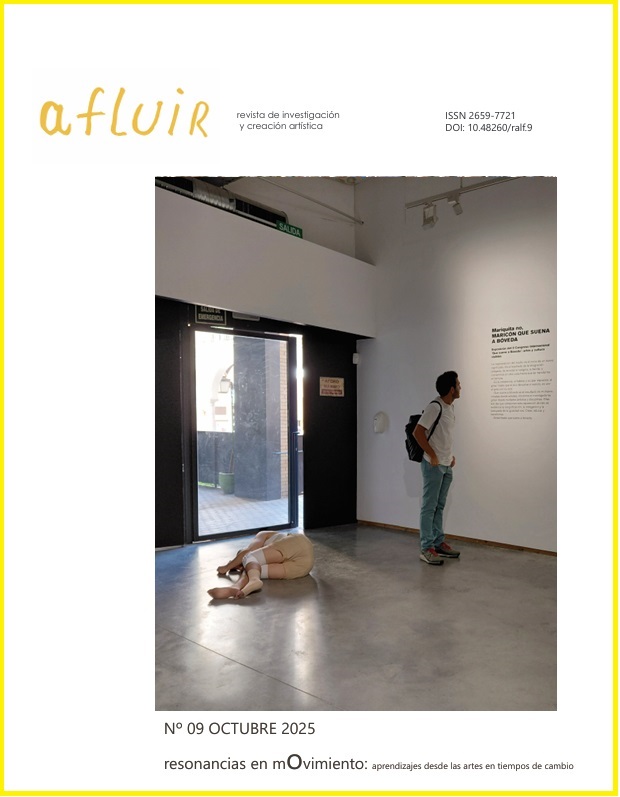Artistic action as a means for the social visibility of the deaf community.
Abstract
This article is an approach to the narrative-based research titled Look at me, I want to talk to you. Visibility and social interaction of the deaf community through artistic action. From the analysis of socio-educational mediation work through the arts with the group, and from repeatedly recounting the process, results, and conclusions reached over the years of working with them, this narrative approach emerges. Through it, the need to take a further step becomes evident—namely, to narrate.
Based on a series of artistic practices carried out with the Provincial Association of Deaf People of Jaén, the collection of their results, and the awareness of the need to create a communication channel with people outside the community—so that society can better understand the reality of this community and the individuals within it—the idea arose to create a public exhibition showcasing the work produced with APROSOJA.
It could be said that this article presents a creative research process, structured narratively. It is an inquiry that has led me to the exhibition format, which appears to offer a solution to the visibility issue that so deeply concerns the community. In other words, it seeks to answer the question: Can artistic action serve as a means for the visibility and social interaction of the deaf community with the rest of society?
References
Blumer, H. (1982). El Interaccionismo simbólico, perspectiva y método. Barcelona: Hora D.L.
Bourriaud, N. (2006). Estética relacional. Buenos Aires: Adriana Hidalgo Editora.
Cerrada, M. (2011). La mano del artista. Revista www.hipo-tesis.eu. Serie Hipo I. Madrid. Recuperado de: http://www.hipo-tesis.eu/numero_hipo_i.html
Confederación Estatal de Personas Sordas, CNSE (s.f.). http://www.cnse.es/index.php
Demetrio, D. (1999). Il gioco della vita. Kit autobiografico. Trenta proposte per il piacere di raccontarsi. Guerini e Associati.
Dewey, J. (1980). El arte como experiencia. Barcelona, Buenos Aires y México: Ed. Paidós Estética.
Formenti, L. (2003). Una metodologia autonarrativa per il lavoro sociale. In Animazione Sociale, n. 12, Dicembre pp. 29-41.
García Canclini, N. (2010). La Sociedad Sin Relato. Antropología y Estética de la Inminencia. Uruguay: Katz Editores.
Hauser, A. (1969). Introducción a Historia del Arte. Madrid: Guadarrama.
Martínez, M. (2017). Un lugar común. El proceso colaborativo desde mi experiencia como a/r/tografa. Tercio Creciente, págs. 117-130. DOI: 10.17561/rtc. n11.8.
Moreno González, A. (2010). La mediación artística: un modelo de educación artística para la intervención social a través del arte. Publicado en Revista Iberoamericana. No. 52/2. Organización de Estados Iberoamericanos para la Educación, la Ciencia y la Cultura. Recuperado de: https://www.researchgate.net/publication/42596813_La_mediacion_artistica_un_modelo_de_educacion_artistica_para_la_intervencion_social_a_traves_ del_arte
Moreno, M. I., Huijbregt, L. y Ramírez, A. (2012). Conocimiento estético y percepción háptica en la experiencia del arte como motor en las relaciones humanas. Red Visual, 17, págs. 15-22. Recuperado de: http://www.redvisual.net/pdf/17/redvisual17_02_moreno-huijbregt- ramirez.pdf
Rico, M. (2018). Creación artística de resistencia a los procesos de significación que excluyen las enfermedades. Tercio Creciente, 14, págs. 77-86. https://dx.doi.org/10.17561/rtc.n14.6
Saldanha, Ângela (2014). NO CAMINHO PARA CASA um estudo a/r/tográfico de recolha de memórias numa comunidade informal. Tesis Doctoral. Oporto: Universidade de Oporto.
Santos Sánchez-Guzmán, Eva María (2011). Posibles terapias para una sociedad patológica. Arte y políticas e identidad. Vol. 4, pp.63-80. Recuperado de: http://revistas.um.es/api
Santos, E. (2013). Reflexiones en torno a la investigación en arteterapia. Red Visual, 19, págs. 17-.29. Recuperado de: http://www.redvisual.net/pdf/19/redvisual19_02_santos.pdf.
Torres de Eça, Teresa (2016). Del arte por el arte a las artes comprometidas con las comunidades: paradigmas actuales entre educación y artes. Publicado en (pensamiento), (palabra). Y oBra, 16(16). https://doi. org/10.17227/ppo.num16-3972
Winner E. et al. (2006). Studio thinking: how visual arts teaching can promote disciplined habits of mind. En Locher P. et al. (Eds), New directions in Aesthetics, Creativity, and the Arts. Baywood.



